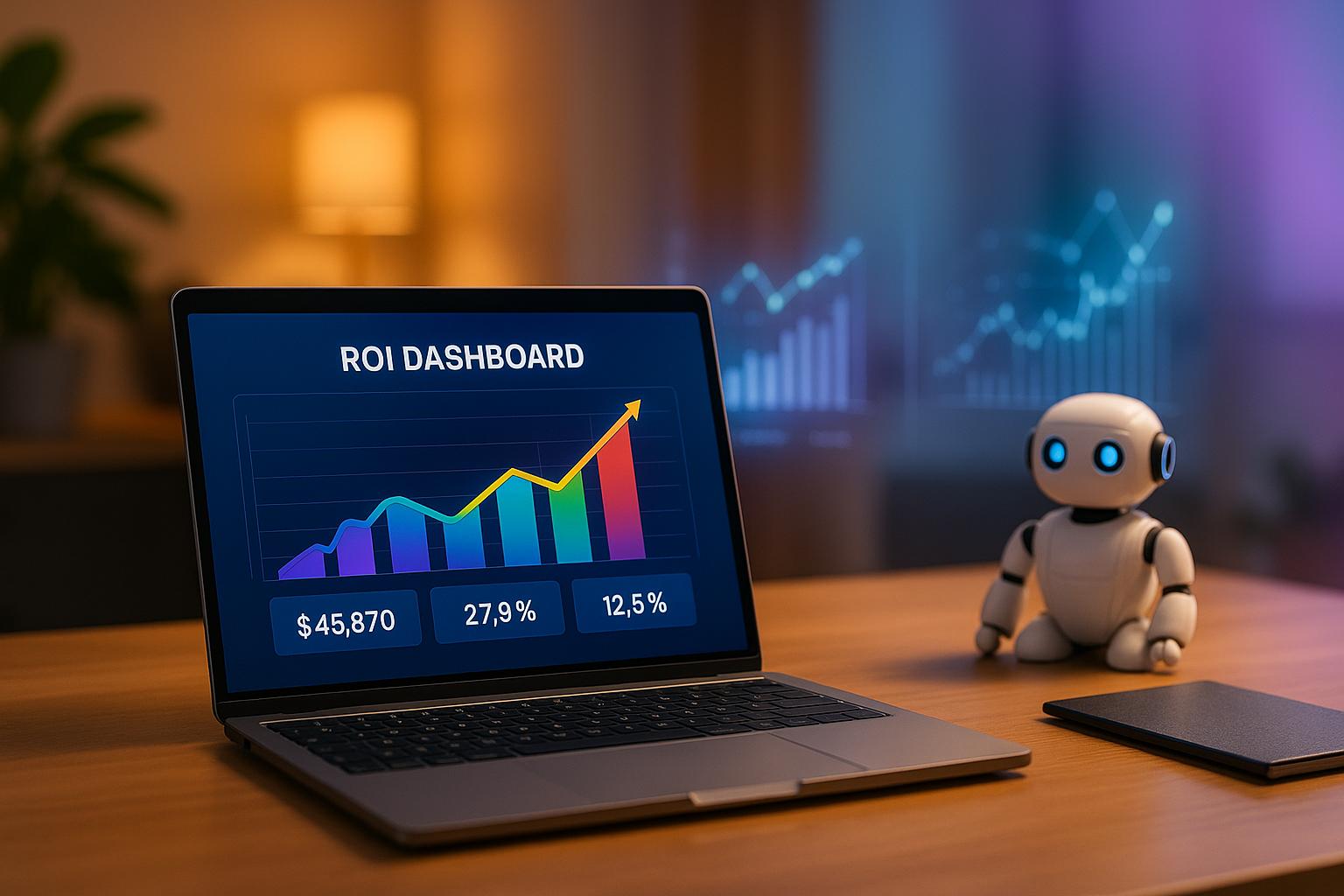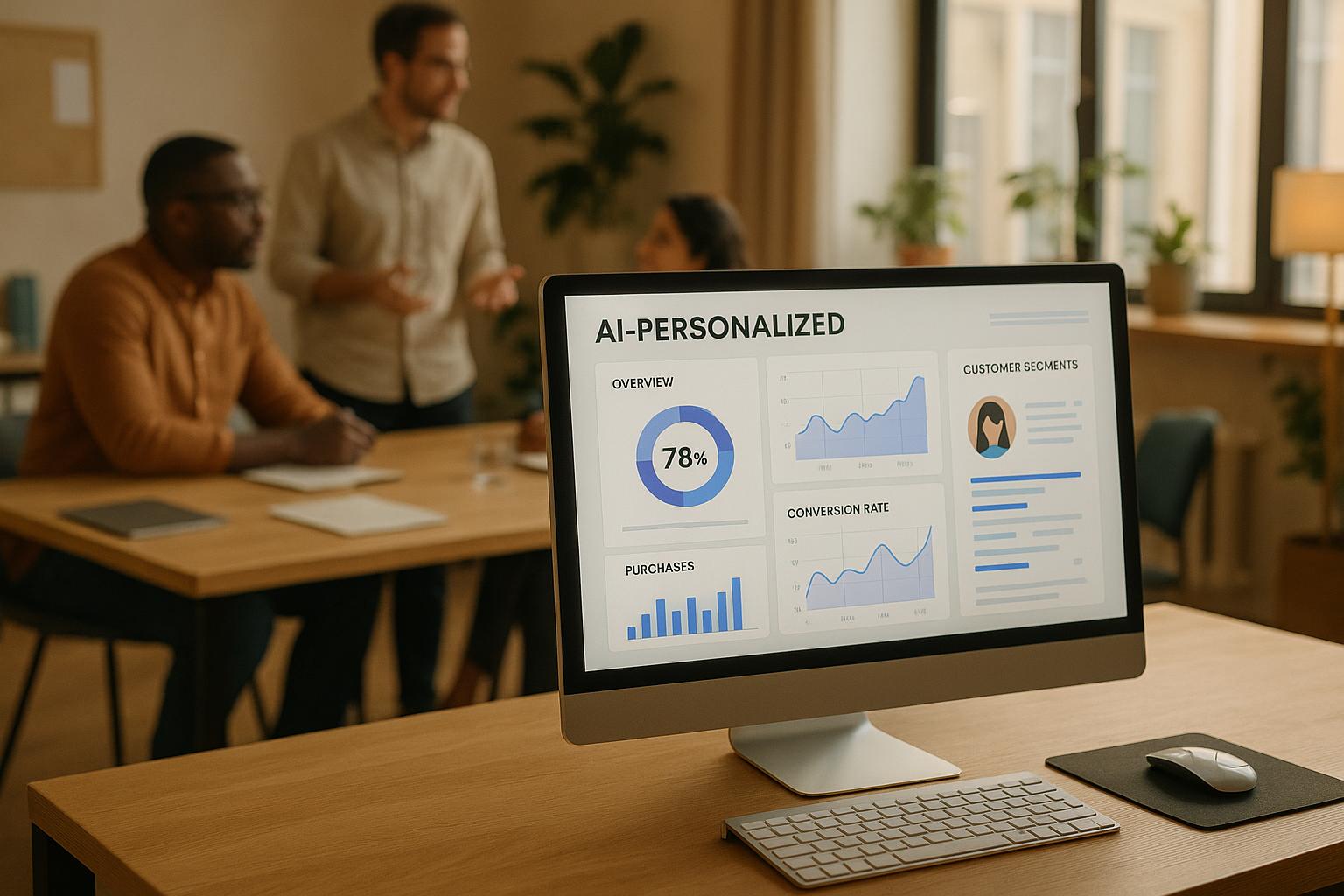Custom dashboards help agencies improve client satisfaction, streamline operations, and maintain brand identity. For example, DigitalForce, a New York-based agency, implemented a white-label dashboard, increasing revenue by 245% in 12 months and achieving ROI in just three months. Here’s what you’ll learn:
- Why customize dashboards: For brand consistency, client-specific reporting, and efficient workflows.
- Key features to look for: Data integration, white-label branding, customizable templates, and security compliance.
- How to design dashboards: Focus on client goals, add branding, and ensure ease of use.
- Advanced features: Live data, AI-driven insights, and tailored views for specific industries.
With tools like White Label AI Solutions, agencies can quickly deploy branded dashboards and boost client engagement. Let’s explore how to create dashboards that deliver results.
Dashboard Basics for Agencies
What Agency Dashboards Do
Agency dashboards act as central hubs for managing client data, tracking performance metrics, and organizing reporting workflows. They pull key metrics from multiple sources into one place, making it easier to analyze, track, and share insights with clients.
These dashboards typically handle three main tasks:
- Real-time visualization: Transform raw data into easy-to-understand visuals.
- Automated reporting: Schedule and send client reports without manual effort.
- Performance tracking: Keep an eye on KPIs and campaign metrics across various platforms.
Take DigitalForce, a New York-based agency, as an example. After implementing a custom reporting dashboard into their existing tools, they boosted their client retention rate to 94%. This shows how tailoring dashboards to your agency's needs can have a direct impact on client satisfaction and loyalty.
Why Customize Your Dashboard
Customizing your dashboard isn’t just about making it look good - it’s about creating a tool that works for both your agency and your clients. Here’s why it matters:
- Brand Consistency: Your dashboard should mirror your agency’s branding and professionalism. When clients log in, they should instantly recognize your brand, which builds trust and reinforces your credibility. Tools like White Label AI Solutions (https://innovaai.io) offer dashboard templates that agencies can rebrand.
- Client-Specific Reporting: Every client has unique goals and focuses on different metrics. A customized dashboard lets you highlight the KPIs that matter most to each client, adjust how data is presented, and even create templates tailored to specific industries.
- Streamlined Operations: Custom dashboards that integrate seamlessly with your current tools can simplify workflows and save time. Thoughtful customizations can improve your agency’s productivity and positively impact your bottom line.
The goal is to strike the right balance between functionality and ease of use. By focusing on practical customizations, you can deliver value to your clients while maintaining strong, lasting relationships.
White Label Options for Customized Dashboards and Reports
How to Pick a Dashboard Platform
Choosing the right dashboard platform is a crucial step in delivering effective reporting for your clients while keeping your operations efficient. The platform you select will shape your agency's ability to provide customized and scalable solutions.
Key Features to Look For
When evaluating platforms, make sure they include:
Data Integration
- Ability to connect with multiple data sources
- Real-time syncing of data
- API access for tailored integrations
- Automated data refresh schedules
Customization Options
- White-label branding to match your agency’s identity
- Customizable report templates
- Adjustable widget layouts
- Metrics tailored to individual clients
Security and Compliance
- Adherence to GDPR standards
- Role-based access controls
- Data encryption to protect sensitive information
- Regular updates to address security vulnerabilities
Comparing Dashboard Tools
Some enterprise-level tools may take months to fully implement, but modern platforms like White Label AI Solutions (https://innovaai.io) offer faster deployment, helping agencies achieve results more quickly. This platform is particularly appealing for its AI-driven reporting features and seamless integration with existing systems.
When comparing tools, consider the following:
Implementation Requirements
- Level of technical expertise needed
- Availability of training resources
- Complexity of integrations
- Estimated setup time
Cost Structure
- Initial setup fees
- Monthly subscription rates
- Pricing per client
- Costs for additional features
Support and Training
- Access to technical support
- Quality of user documentation
- Availability of training materials
- Community forums or resources
Dashboard Design Guide
Creating a successful agency dashboard means balancing functionality with an appealing design. Every choice - whether it's selecting metrics, organizing the layout, or incorporating branding - plays a role in improving client engagement and operational workflows.
Choosing Your Metrics
Focus on metrics that align with your client's goals. Highlight KPIs that impact their business outcomes and showcase the value your agency provides.
Key Metrics to Include
- Campaign ROI and conversion rates
- Customer acquisition costs
- Revenue trends
- Engagement statistics
- Client-specific objectives
For example, one agency improved client retention by concentrating on metrics that mattered most to their clients. Once you've chosen the right data, integrate it with your agency's visual identity to make the dashboard both functional and visually appealing.
Adding Your Brand
A branded dashboard strengthens the client experience by making it feel cohesive and professional. Use these elements to incorporate your brand:
Branding Essentials
- Add your logo in a prominent but non-intrusive spot
- Apply your brand's color palette consistently
- Use typography that reflects your agency's style
- Customize widget designs and layouts
- Create branded templates for reports
Consistency is key. A well-branded dashboard enhances the way data is presented without distracting from the information itself.
Making Dashboards Easy to Use
A user-friendly dashboard is essential for both client satisfaction and team productivity. Keep these principles in mind:
Organizing the Layout
- Group related data points together
- Place the most important metrics at the top
- Use consistent formatting and clear labels
- Ensure navigation is simple and intuitive
DigitalForce's dashboard overhaul is a great example of this. By focusing on intuitive layouts during a six-week implementation period, they created a system that clients could easily navigate and understand.
Dashboard Hierarchy Table
| Level | Content Type | Purpose |
|---|---|---|
| Primary | Key Performance Metrics | Provides immediate, high-level insights |
| Secondary | Detailed Analytics | Offers deeper analysis of performance |
| Tertiary | Supporting Data | Adds context and background details |
For agencies looking to simplify dashboard creation while maintaining branding, white-label platforms like White Label AI Solutions (https://innovaai.io) offer tools that combine advanced analytics with customizable design options. These solutions can save time while delivering a professional, tailored experience.
Advanced Dashboard Features
Building on personalized designs and data integration, advanced features give agencies the tools to gain deeper insights and provide more value to their clients.
Setting Up Live Data
Real-time data supports faster decision-making. To implement live updates effectively:
- Establish API connections to ensure smooth data flows.
- Set refresh intervals based on the importance of the data.
- Enable error monitoring and alerts to catch issues early.
- Configure backup storage to protect critical data.
- Test the system's performance to ensure reliability.
Plan updates wisely - use real-time updates for high-priority metrics, while less critical data can have longer refresh intervals to save resources.
Building Custom Data Views
Custom views allow you to display information tailored to a client’s specific needs. With live data, these views accurately reflect current performance metrics. For example, DigitalForce achieved a 94% client retention rate by using a well-designed custom reporting dashboard.
Adding AI Features
Custom data views create the foundation for AI tools to provide smarter insights and reporting. AI can improve dashboards by offering:
- Trend forecasting with predictive analytics.
- Automated alerts for unusual data patterns.
- Easy-to-use natural language queries.
- Recommendations for better data visualizations.
- Automatically generated reports.
Choose AI tools that directly improve client results and work seamlessly with your existing dashboard setup. White-label platforms can deliver these features while keeping your branding consistent and professional.
Client-Specific Dashboard Setup
Create dashboards tailored to each client's specific industry needs for better insights and performance tracking.
Dashboards by Client Type
Different industries require unique metrics to measure success effectively. For e-commerce clients, focus on conversion rates, average order value (AOV), and inventory metrics. Service-based businesses often prioritize project timelines and client satisfaction scores, while non-profits benefit from tracking donor engagement and campaign impact.
Here’s an example: DigitalCraft’s specialized e-commerce dashboard led to a 95% boost in mobile conversions and a 75% increase in AOV - all in just three months.
Managing Client Access
Keep dashboards secure and user-friendly by implementing the right access controls:
| Access Control Feature | Purpose | Benefit |
|---|---|---|
| Role-based permissions | Control data visibility | Safeguard sensitive information |
| GDPR compliance tools | Ensure data privacy | Meet regulatory standards |
| Automated consent management | Handle user permissions | Improve data accuracy |
By aligning client access with your branding strategy, you can build trust and ensure smooth operations.
"Best-in-class GDPR compliance and automation. Onboarding was seamless with dedicated technical support. Their cookieless tracking solution solved our privacy concerns while maintaining 98% data accuracy. The automated consent management is brilliant."
Using Client Input
"Particularly impressed with their custom reporting dashboard - clients love it. Increased our revenue by 245% in 12 months."
Gather client feedback, monitor how dashboards are used, and track key metrics to identify areas for improvement. Quickly implement updates and document changes to keep everything running smoothly. White-label solutions make this process even easier, allowing you to maintain your agency’s branding while delivering consistent results.
Focusing on client-specific needs strengthens your agency’s value in every interaction.
Summary
Custom dashboards can significantly improve both efficiency and client engagement. A great example is DigitalForce, which saw exceptional growth thanks to a tailored white-label solution. This highlights how white-label AI tools are shaping modern dashboard customization.
Other agencies have seen notable success with similar approaches. For instance, TechWave, based in California, cut client acquisition costs by 35% and boosted monthly recurring revenue by 225%. Meanwhile, ServCorp Digital in Sydney improved lead quality by 85% within just six months.
"Transformed our agency's capabilities overnight. The white label SEO and AI chatbot services integrated seamlessly with our existing stack... Particularly impressed with their custom reporting dashboard - clients love it. Increased our revenue by 245% in 12 months."
- Sarah Chen, CEO, DigitalForce
For agencies aiming to grow while keeping services personalized, platforms like White Label AI Solutions (https://innovaai.io) provide dashboards that combine automation with analytics. These intuitive and advanced tools help agencies and their clients make smarter, data-driven decisions.


